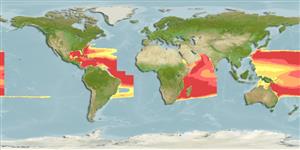Classification / Names
Nombres comunes | Sinónimos | Catalog of Fishes(Género, Especie) | ITIS | CoL | WoRMS | Cloffa
>
Lophiiformes (Anglerfishes) >
Himantolophidae (Footballfishes)
Etymology: Himantolophus: Greek, himas or himantos = leather strap, thong or leash (referring to the thick leathery illicium) + Greek, lopho or lophio = crest or tuft (referring to the baited illicium projecting from the head) (Ref. 86949).
Environment: milieu / climate zone / depth range / distribution range
Ecología
marino batipelágico; rango de profundidad 0 - 1900 m (Ref. 40877). Deep-water
Western Indian Ocean: Natal, South Africa. Also known from the western and central Pacific and northwestern and central Atlantic.
Tamaño / Peso / Age
Maturity: Lm ? range ? - ? cm
Max length : 20.8 cm SL (female)
Short description
Morfología | Morfometría
Radios blandos dorsales (total): 5; Radios blandos anales: 4. Distinguishing characteristics of metamorphosed female: length of illicium 29-35% SL; each primary branch of distal escal appendage with posterior side branch situated near base; length of distal escal appendage increasing from 9% SL in 2.7 cm specimens to 54% SL in 5.2 cm specimen and 72% SL in 9 cm specimen; posterior side branch of distal escal appendage length increasing from 4.3% SL in 2.7 cm specimens to 30% SL in 5.2-9 cm specimens; distal escal appendage lacking small dermal spinules (Ref. 86949).
Males unknown (Ref. 40877). Minimum depth from Ref. 58018. Most recent record was from 29°25'S that was recovered from the stomach of a beached sperm whale (Ref. 85522).
Life cycle and mating behavior
Madurez | Reproducción | Puesta | Huevos | Fecundidad | Larva
Anderson, M.E. and R.W. Leslie, 2001. Review of the deep-sea anglerfishes (Lophiiformes: Ceratioidei) of southern Africa. Ichthyological Bulletin of the J.L.B. Smith Institute of Ichthyology 70:30 p. (Ref. 40877)
IUCN Red List Status (Ref. 130435)
Threat to humans
Harmless
Human uses
Más información
Nombres comunesSinónimosMetabolismoDespredadoresEcotoxicologíaReproducciónMadurezPuestaAgregación para la puestaFecundidadHuevosEgg development
Age/SizeCrecimientoLength-weightLength-lengthLength-frequenciesMorfometríaMorfologíaLarvaDinámica larvariaReclutamientoAbundanciaBRUVS
ReferenciasAcuiculturaPerfil de acuiculturaRazasGenéticaElectrophoresesheritabilidadEnfermedadesProcesamientoNutrientsMass conversion
ColaboradoresImágenesStamps, Coins Misc.SonidosCiguateraVelocidadTipo de nataciónSuperficie branquialOtolitosCerebrosVisión
Herramientas
Special reports
Download XML
Fuentes de Internet
Estimates based on models
Preferred temperature (Ref.
123201): 5.9 - 16.7, mean 10.2 °C (based on 390 cells).
Phylogenetic diversity index (Ref.
82804): PD
50 = 0.5000 [Uniqueness, from 0.5 = low to 2.0 = high].
Bayesian length-weight: a=0.01995 (0.00906 - 0.04395), b=3.01 (2.83 - 3.19), in cm total length, based on all LWR estimates for this body shape (Ref.
93245).
Nivel trófico (Ref.
69278): 4.0 ±0.54 se; based on food items.
Fishing Vulnerability (Ref.
59153): Low vulnerability (15 of 100).
